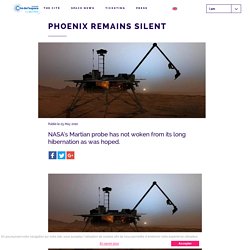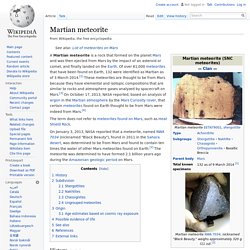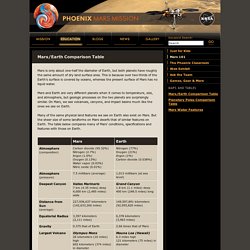

En.cite-espace. An artist’s impression showing Phoenix on the surface of Mars.

This probe landed close to the north polar ice cap on Mars, at almost 70° north latitude.Credit: NASA The American Space Agency has just officially announced that it has stopped its campaign to listen for Phoenix which landed in the north of Mars on 25 May 2008, exactly 2 years ago. Stationary, but equipped with a robotic arm which enabled it to take samples, this probe had successfully completed its mission, transmitting vast amounts of data and images from a region that is covered with dry ice in winter. Moreover, just before the arrival of the latter in November 2008, Phoenix stopped working because the Sun was getting lower and lower in the sky and its solar array could not supply sufficient power. The Vastitas Borealis region photographed by Phoenix. Best (And Worst) Mars Landings Ever.
Hi-SEAS and Mars Society kick off new season of missions. The Hawaii Space Exploration Analog and Simulation (aka.

Hi-SEAS) – a human spaceflight analog for Mars located on the slopes of the Mauna Loa volcano in Hawaii – just kicked off its third research mission designed to simulate manned missions on Mars. Located at an elevation of 2500 meters (8,200 feet) above sea level, the analog site is located in a dry, rocky environment that is very cold and subject to very little precipitation. While there, the crew of Mission Three will conduct detailed research studies to determine what is required to sustain a space flight crew during an extended mission to Mars and while living on Mars. The six-member team includes Martha Lenio (Commander), Allen Mirkadyrov, Sophie Milam, Neil Sheibelhut, Jocelyn Dunn, and Zak Wilson, with Ed Fix and Micheal Castro in Reserve.
Snc meteorite. The term does not refer to meteorites found on Mars, such as Heat Shield Rock.

On January 3, 2013, NASA reported that a meteorite, named NWA 7034 (nicknamed "Black Beauty"), found in 2011 in the Sahara desert, was determined to be from Mars and found to contain ten times the water of other Mars meteorites found on Earth.[2] The meteorite was determined to have formed 2.1 billion years ago during the Amazonian geologic period on Mars. History[edit] By the early 1980s, it was obvious that the SNC group of meteorites (Shergottites, Nakhlites, Chassignites) were significantly different from most other meteorite types.
Among these differences were younger formation ages, a different oxygen isotopic composition, the presence of aqueous weathering products, and some similarity in chemical composition to analyses of the Martian surface rocks in 1976 by the Viking landers. Subdivision[edit] Shergottites[edit] Roughly three-quarters of all Martian meteorites can be classified as shergottites. Elizabeth Howell mars mock - others. The Asteroid that Flattened Mars. «Mars-500» project. Earth to Mars: An Interactive Timeline. NASA Curiosity Rover To Drill First Martian Sandstone 'Windjana' : Science. By Rebekah Marcarelli r.marcarelli@hngn.com | Apr 27, 2014 02:48 PM EDT "NASA's Curiosity Mars rover has driven within robotic-arm's reach of the sandstone slab at the center of this April 23 view from the rover's Mast Camera.

The rover team plans to have Curiosity examine a target patch on the rock, called "Windjana," to aid a decision about whether to drill there. " (Photo : NASA/JPL-Caltech/MSSS) NASA's Curiosity rover is set to inspect a slab of sandstone that could be a potential drilling target. The rock could be the first drilling target that is not a mudstone, a NASA Jet Propulsion Laboratory news release reported. The stone was dubbed "Windjana," after a gorge located in Western Australia. The rover will inspect the rock using its camera and X-ray spectrometer and will also brush dust away from a segment of it. If chosen as a drilling site the rover will collect dust samples from deep within the rock and deliver them to onboard laboratory instruments. Phoenix Mars Mission - Education - Mars 101 - Mars/Earth Comparison Table. Mars is only about one-half the diameter of Earth, but both planets have roughly the same amount of dry land surface area.

This is because over two-thirds of the Earth's surface is covered by oceans, whereas the present surface of Mars has no liquid water. Mars and Earth are very different planets when it comes to temperature, size, and atmosphere, but geologic processes on the two planets are surprisingly similar. On Mars, we see volcanoes, canyons, and impact basins much like the ones we see on Earth. Many of the same physical land features we see on Earth also exist on Mars. But the sheer size of some landforms on Mars dwarfs that of similar features on Earth. Carbon dioxide (95.32%) Nitrogen (2.7%) Argon (1.6%) Oxygen (0.13%) Water vapor (0.03%) Nitric oxide (0.01%) Nitrogen (77%) Oxygen (21%) Argon (1%) Carbon dioxide (0.038%) 1,013 millibars (at sea level) Valles Marineris 7 km (4.35 miles) deep 4,000 km (2,485 miles) wide Grand Canyon 1.8 km (1.1 miles) deep 400 km (248.5 miles) long.